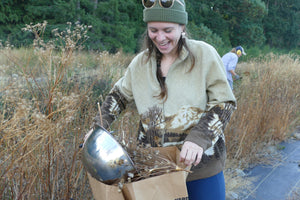The Weekly with Daly: Monoecious vs. Dioecious Plants

The Weekly with Daly is a regular column about the musings of the nursery written by our in-house wildlife observer and passionate conservationist, Julia Daly.
The Weekly with Daly: Monoecious vs. Dioecious Plants
September 3, 2021
This week I will delve into the topic of plant reproduction by explaining the difference between monoecious and dioecious plants. While this may sound dull at first, it pays to know the difference if you are interested in plant propagation or growing plants for their edible seeds or fruits. So let’s compare the two.
In monoecious species, each plant has some male flowers (with stamens) and some female flowers (with pistils); therefore, do not require a partner plant of the opposite sex to achieve pollination — just the help of wind or a pollinating animal. Interestingly, some monoecious plants have bisexual flowers. Bisexual flowers are termed “perfect” because they contain both male and female reproductive organs. Monecious plants may have either perfect (bisexual) flowers or imperfect flowers depending on the species.
In contrast, dioecious species have distinctly male or female plants. That is, some plants have only male flowers, while other plants of the same species have only female flowers. The flowers of monoecious species are always imperfect so require a corresponding male or female plant to produce viable seeds or fruit.
If you ever get confused, just refer to the Greek pre/suffixes. Mono = one, di = two, and ecious = house. Therefore, monoecious = one house (i.e., male and female reproductive parts live in the same ‘house’) and dioecious = two houses.
Here are a few examples of monoecious and dioecious plants found on Southern Vancouver Island.
I hope you’ve enjoyed this Weekly with Daly.
Signing off,
Julia
Photo Examples of Monoecious Plants:

Figure 1 (above). Monoecious Fireweed (Chamerion angustifolium ssp. angustifolium) has perfect flowers.

Figure 2 (above). Monoecious Chocolate lily (Fritillaria affinis) has perfect flowers.



Figures 3 - 5. Monoecious Beaked hazelnut (Corylus cornuta) has imperfect flowers. The magenta-coloured female flowers (top) and male catkins (middle) bloom on the same plant in late winter before the leaves appear. Developing nut (bottom). Hazelnuts are wind-pollinated.
---------------------------------
Photo Examples of Dioecious Plants:


Figures 6 - 8. Dioecious Osoberry or June Plum (Oemleria cerasiformis). The female flowers (top), and male flowers (middle) bloom on separate plants in late winter to early spring. Only the female plants will bear fruit (bottom).

Figure 9. Dioecious Trailing blackberry (Rubus ursinus). The male flower (left), and the female flower (right) bloom on separate plants in mid-spring. Only the female plants will bear fruit.
- Satinflower Nurseries







